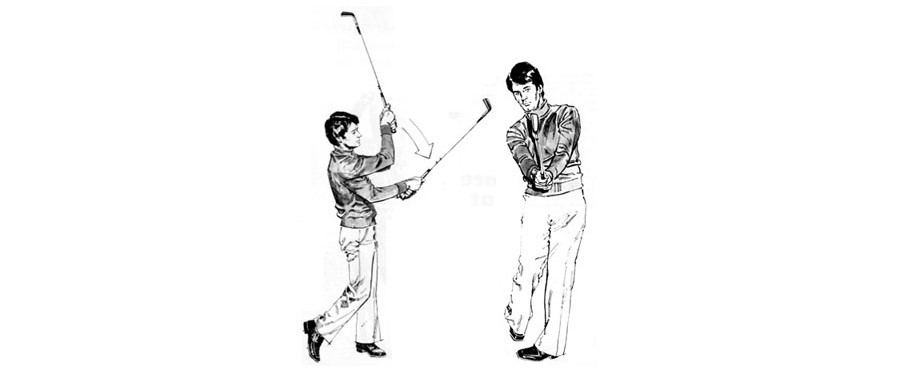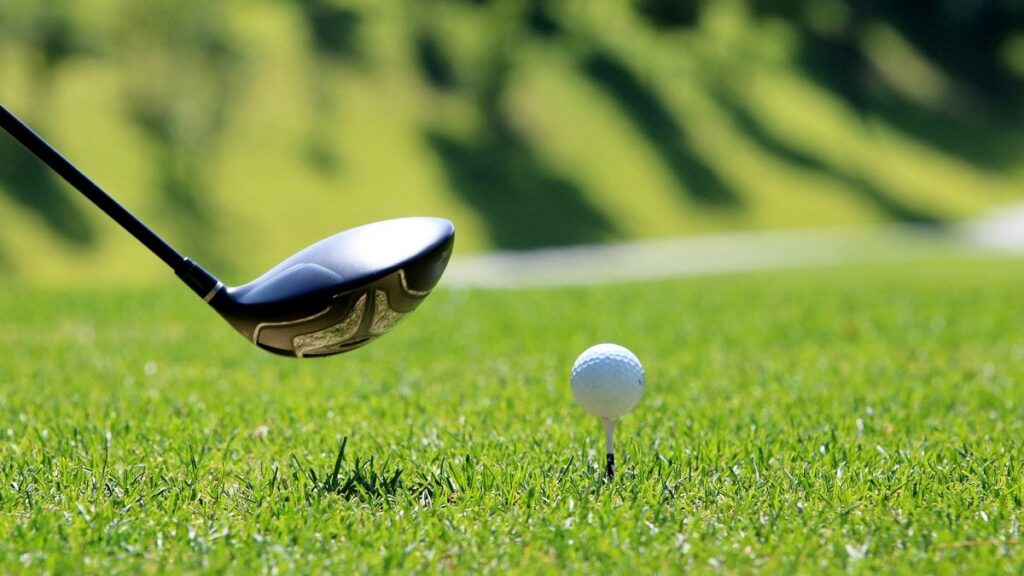Leslie King Tuition 12
We have traced through the entire downswing sequence. At the finish of your swing the body should be perfectly balanced with the chest squarely facing the target, and the hands alongside the head at about the level of the left ear. The arms are entirely free of tension, with both elbows pointing downward. the forearms thus resemble the two sides of a narrow-based triangle, not precisely vertical, but definately not splayed out.

Estimated reading time: 6 minutes
Control of this finish is held from the waistline and the firm left leg. The right knee alongside the left and the right foot is up on the toe. This too is contributing to balance.
Leslie King Tuition 12
Checking your swing
From this position, allow the hands to drop to hip level, bringing the shaft of the club to an angle of about 45 degrees to the ground. Now check that the face of the club is still square. That is, the leading edge of the club face or blade should be vertical when viewed by the player.

Leslie King Tuition 12
If it is off vertical, to either right or left, wrist rolling has taken place through the ball either at or after impact. If the leading edge is off vertical to the left, the hands have rolled the face into a closed position. If it is off vertical to the right the hands have opened the face.

Leslie King Tuition 12
Note that I said at or after impact. Why be concerned about what happens after impact?
The answer is that if the face is coming out of alignment after impact it is only a matter of time before it happens pre-impact. Further, errors of face alignment at or after impact can be sufficient to affect accuracy just that little bit.
Leslie King Tuition 12
The important thing is that the face must be square at finish. If is coming out of alignment you must discover where and when.
If the face is not square at the finish check your position at the top that was outlined in Lesson 3.
The finish reveals a great deal. Generally speaking, a good player is flattish on the backswing and upright in the finish. The poor player is upright in the backswing and flat in the finish. The former has achieved a club-line through the ball. The latter has not. His club has moved across the line of flight through impact, from out to in, which is evident in his type of finish. The finish reveals how good, or bad, your club-line has been!

Leslie King Tuition 12
Here is an absolutely vital exercise that every golfer must master. Everything in this course of instruction depends on your ability to do this exercise to perfection.
Its purpose is simple. It is designed to eliminate, once and for all, the dreadful “concave” body shape (illustrated) which is the cause of all that is bad in the golf swing.

Leslie King Tuition 12
This exercise can be performed anywhere, as you do not need a club in your hands to do it. Indeed if you cannot do it without a club, you certainly will never master it with a club.
Every professional golf teacher should insist that this exercise is mastered by novices before they ever actually swing a club. If they did it would save months of hard work. Experienced players too, should be introduced to it immediately. This exercise, more than anything else, has enabled me to transform players in less than two years to championship and international class.
It contains the very essence of a correct swing movement. It absolutely must be mastered if you are to become a good golfer.
Most players as we have described earlier in this course of instruction allow their bodies to rise up in the backswing as the club swings to the top. Again, in the downswing, they tend to move the club down from the top with “body propulsion” rotating the shoulders through the ball as they do. They end up with a flat “round” type of finish with the shaft of the club pointing to the left of target.
Adopt the normal adress position with the left shoulder slightly higher than the right one, grasp the extended left arm around the wrist with the right hand. Now perform the backswing by swinging the left hand and arm to the top of the backswing.
Be sure to make a free swing with the left shoulder “up”. but keep your weight “down” as the left hand and arm swing up. Feel the left arm is swinging to maximum leverage.
This will help you to sense that the body turns to permit a free swing of the left hand and arm.
You will also feel the need to raise the left heel in order to achieve maximum lverage. Remember, the left foot must “break” at the toe joints. There must be no inward roll of the left foot. And feel the right knee remains flexed, just as it was at the address.
Performing this exercise makes us realise that a responsive and perfectly balanced body enables the left hand and arm to swing fully and freely. It also places the arms in a correct position at the top.
At the top, the shoulders are fully turned and remain so as the downswing begins. We now swing the left hand and arm down into the ball, noting that the lateral shift occurs as a result of this downward swing.
As the left hand enters the “release area” the right foot and knee “kicks in” to the shot.
The left hand and arm then moves into and along the intended line of flight through impact, causing the shoulders to turn after impact to allow the left hand and arm to swing freely up into the finish.
In short this exercise contains the essence of the entire swing movement and can be performed anywhere without a golf club. It reinforces all the points that I have been making about a correct swing action.
Perform this exercise often standing in front of a mirror. Compare your body position with these illustrated and make sure you have every detail perfect. Repeat the exercise until it becomes automatic.
Above all, it teaches you to perform the body turn without allowing the body to asume that “concave” shape. If you cannot achieve a correct “convex” body shape without a club in your hands, you certainly will not be able to do it with a club!
